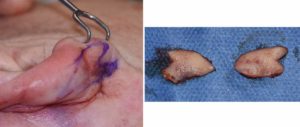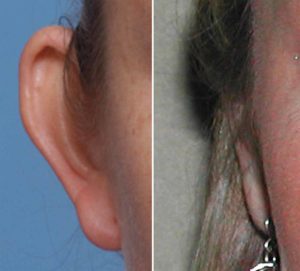Otoplasty or ear pinning is the most common aesthetic surgery performed on the ear and its cartilages. (technically earlobe repair would be the most common aesthetic ear surgery… but it contains no cartilage) In repositioning the shape of the protruding ear back towards the side of the head a variety of techniques are used to reshape the underlying supporting ear cartilages. Some of these are suture plications while others involve modification or removal of sections of ill-formed cartilage.
But in ear reshaping surgery consideration must be given to the only non-cartilaginous structure of the ear…the earlobe. This small area of the ear is frequently overlooked in otoplasty and can mar the aesthetic result of an otherwise pleasing reshaped ear. In many cases if the cartilage of the ear its pulled back but the earlobe remains too far forward, the ear will still standout but to a lesser degree. A protruding earlobe disturbs an otherwise smooth helical rim line from the top of the ear downward. Such otoplasty patients with earlobes that need to be simultaneously addressed can be identified beforehand.


Dr. Barry Eppley
Indianapolis, Indiana



